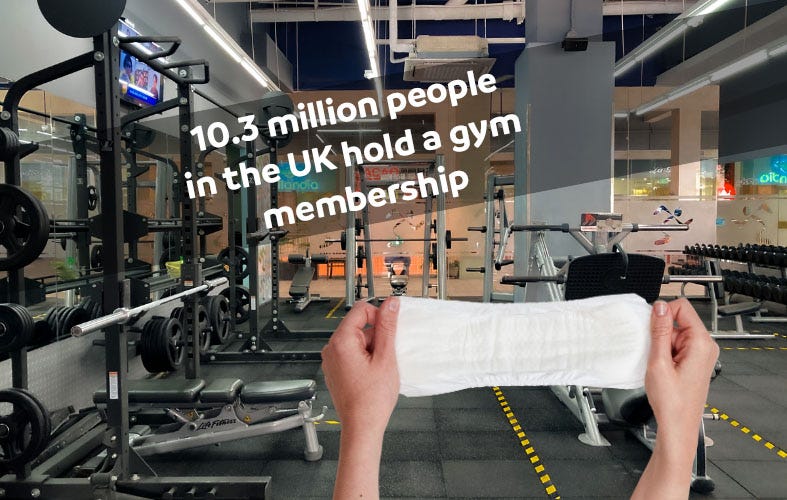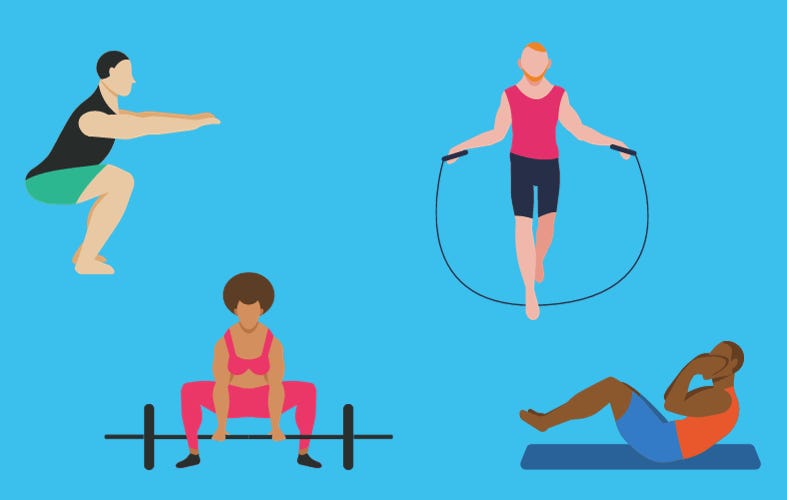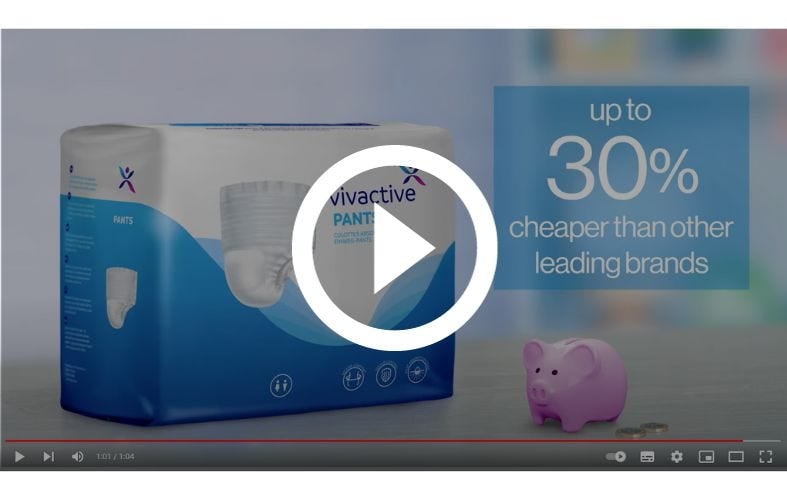
Share this page with friends
Incontinence when exercising: What you need to know
Can you exercise when incontinent? Yes, yes you can. For gym regulars, exercise makes up part of an important wellness routine and developing incontinence can put a serious dampener on your overall mental wellbeing. I won’t sugarcoat it for you, it’s not all rainbows and unicorns, avoiding leakage whilst exercising is a tough one, but it’s possible!

What is incontinence when exercising?
If you’re experiencing leaks when you exercise, more likely than not it’s a type of stress incontinence. This is when your pelvic floor muscles are unable to stop your bladder from leaking due to the pressure put on it when exercising.
If you’re not familiar with the types of incontinence, see our blog ‘What is Urinary Incontinence’ for more information.
Urinary incontinence symptoms when exercising
The main symptom you would experience is urine leakage. As we mentioned before, this is usually stress incontinence, and if you frequently leak during exercise then the chances are this is also the case when you sneeze, cough, laugh, or lift heavy objects.
Understanding and preparing for exercise with incontinence
Exercising with bladder weakness or bowel problems requires a proactive approach to ensure comfort, confidence, and effective management. By following these guidelines you can start to navigate those gym sessions a bit easier:
Wear the right incontinence product:
Choosing the right product is a biggy for managing leaks during exercise. Some brands have developed pants specifically with active lifestyles in mind. For example, Vivactive has a range of men’s ‘active fit’ incontinence pants designed with RAPIDABSORB Tubes™ to quickly absorb liquid and keep you fresh and dry.
It's also worth experimenting with different styles – some people prefer the security of briefs, while others find pads more comfortable for certain activities. Think about the fit as well. A snug but not too tight fit will prevent slippage and ensure the product works effectively. Look for features like elasticated leg cuffs and a secure waistband.
Stay hydrated, but not too much:
Hydration is essential for overall health, especially when exercising, but excessive fluid intake can lead to increased urgency and frequency of urination. It’s difficult, but try to strike a balance by monitoring your water intake before and during workouts. We can’t tell you exactly how much to drink as unfortunately this one is a personal learning curve. Make a note of how much you’re drinking so that you can adjust accordingly if anything goes wrong. Also, I can’t stress this enough, do not dehydrate yourself. It’s bad for both your workout session and your incontinence when exercising.
Empty your bladder before exercising:
Prior to hitting the gym, make sure to empty your bladder completely. This can help minimise the risk of leakage during your workout and give you the confidence to make the most of your exercise routine. Take your time to ensure your bladder is truly empty. Try double voiding, which involves emptying your bladder, waiting a few minutes, and then trying to empty it again. This can be especially helpful for people with urge incontinence, as it can reduce the feeling of urgency during exercise.
Choose the right workout clothes:
Wearing loose-fitting clothing can help conceal any visible incontinence pants or pads, giving you the best of both discretion and comfort. Opting for a loose pair of tracksuit bottoms over a tight pair of gym leggings will put less pressure on your bladder.

Exercise modifications for incontinence management
It's a tough pill to swallow, but if you’re experiencing incontinence you’ll need to make some changes to your workout routine. Certain changes can help you manage incontinence whilst maintaining a healthy exercise regime.
Ditch those heavy compound lifts:
When lifting heavy weights, the increased pressure can lead to bladder leakage. This is particularly true for women who have weakened pelvic floor muscles. Try switching out those heavy barbell squats for bodyweight squats.
Low-impact exercises:
Engaging in low-impact exercises reduces the pressure on your pelvic floor muscles, minimising your risk of leakage. Running and sprinting are staples of the fitness world, but impact from the treadmill or concrete can increase possible leakage. Keep up with the cardio, but instead, why not try activities like walking, cycling, swimming, or using the elliptical machine (cross trainer)?
Consider incorporating more yoga or Pilates into your routine. These exercises can help strengthen core muscles, including the pelvic floor, which can improve bladder control over time. If you do choose to run, try shorter intervals with walking breaks to reduce the overall impact. Running on softer surfaces like a track or trail can also be gentler on your body.
Gradually increase intensity:
If you're new to exercising or have been inactive for a while, start slowly and gradually increase the intensity of your workouts. This allows your body to adjust and reduces the likelihood of sudden leaks due to increased exertion.
Listen to your body closely. If you start to experience any leakage or discomfort, reduce the intensity or duration of your workout. It's better to progress slowly and consistently than to push yourself too hard and risk setbacks. Consider working with a physical therapist or trainer who specialises in pelvic floor health. They can help you design a workout program that is safe and effective for your specific needs.
Plan breaks and toilet visits:
If necessary, plan short breaks during your workout to visit the toilet if you’re experiencing incontinence when exercising. If you need to leave a class early to use the loo, do it. This can help manage urgency and minimise the risk of accidents.
Pelvic floor exercises:
Does exercise help incontinence? Yes, there are some exercises to help with incontinence, but they’re not your typical activities like running etc. It’s pelvic floor exercises.
Strengthening the pelvic floor muscles can significantly improve bladder control. But how do you do that? Incorporate exercises like Kegels into your fitness routine. But what on Earth is a Kegel? A Kegel is an exercise that involves contracting and releasing your pelvic floor muscles, multiple times.
How to perform a kegel:
- Empty your bladder before starting
- Imagine you’re urinating and you suddenly need to stop mid-stream (alternatively, imagine you are trying to stop passing wind)
- You should feel a contraction inside your body in the pelvic area
- Hold the contraction for 3 to 5 seconds, then release
- Wait 3 to 5 seconds and then repeat the contraction
- You can perform this stood up, sat down, or lay down

Best incontinence pads and pants for exercise
Vivactive Men Active Fit
Vivactive Men Active Fit Underwear provides superior protection and comfort for men on the go. The innovative RAPIDABSORB Tubes™ absorb liquid 20% faster than standard incontinence underwear, keeping you dry and fresh. Reinforced anti-leak cuffs offer double the protection against leaks, whether you're standing, sitting, or lying down. Active Odour Control technology neutralises odours, ensuring discretion and confidence. Designed to fit and feel like regular underwear, Vivactive Men Active Fit pulls up easily and features a sporty blue colour. When it's time for a change, simply tear the sides for easy removal and disposal. The discreet design and comfortable fit make Vivactive Men Active Fit ideal for active individuals who want reliable protection without compromising their lifestyle.
TENA Men Active Fit Pads
TENA Men Active Fit Pads offer discreet and comfortable protection for men with active lifestyles. The unique cup shape is designed specifically for the male anatomy, providing a tailored fit and maximum comfort. At only 10mm thin, these pads are virtually undetectable under clothing, allowing for complete discretion. The adhesive strip ensures the pad stays securely in place, even during vigorous activity. The Secure Absorption Zone quickly locks away liquid and prevents it from returning to the surface, keeping skin dry and healthy. Odour Neutraliser technology keeps you feeling fresh and confident, while the individually wrapped pads offer convenience and hygiene. TENA Men Active Fit Pads are a great choice for men who want discreet and reliable protection during exercise and everyday activities.
TENA Men Active Fit Pants
TENA Men Active Fit Pants combine the comfort of regular underwear with reliable incontinence protection. Designed specifically for men, these pants feature a masculine cut, soft stretch material, and an elastic waistband for a secure and comfortable fit. The anatomical design provides protection against leaks, allowing you to stay in control and confident. The Secure Absorption Zone quickly locks away liquid, keeping skin dry and preventing leaks. Breathable materials promote skin health and comfort, while odour-neutraliser technology ensures discretion. TENA Men Active Fit Pants are ideal for men who want the freedom and confidence to stay active without worrying about leaks or discomfort.
TENA Slip Active Fit
TENA Slip Active Fit is designed for individuals with moderate to heavy incontinence who maintain an active lifestyle.
These all-in-one slips feature a plastic backing and a fast-acting absorbent core for reliable protection against leaks. Effective Odour Control neutralises unwanted odours, keeping you feeling fresh and confident. Easy-fix fastening tape ensures a secure and comfortable fit, while elasticated waist and legs provide added protection against leaks. A wetness indicator makes it easy to know when a change is needed.
Attends Slip Active
Attends Slip Active provides effective protection for individuals with heavy to severe incontinence.
These adjustable all-in-ones feature a super absorbent zone that quickly draws moisture away from the skin, preventing dampness and promoting skin health. Effective Odour Control neutralises incontinence-related odours for added confidence. Dermatologically tested materials ensure skin safety and comfort, even with extended wear. Wide wings and re-sealable tape allow for easy application and a secure, adjustable fit throughout the day.
Incontinence when exercising risk factors?
Several factors can increase the risk of experiencing incontinence during exercise. Understanding these risk factors can help individuals take proactive steps to manage their symptoms and maintain an active lifestyle. While incontinence can affect anyone, certain groups are more susceptible.
- Weakened pelvic floor muscles: Pregnancy, childbirth, and ageing can weaken the pelvic floor muscles, making it harder to control urine flow, especially during physical activity.
- High-impact exercise: Activities like running, jumping, and plyometrics place significant stress on the pelvic floor, increasing the risk of leakage.
- Obesity or overweight: Excess weight puts added pressure on the bladder and pelvic floor muscles, making incontinence more likely.
- Certain medical conditions: Conditions like diabetes, enlarged prostate (in men), and urinary tract infections can contribute to incontinence.
- Previous surgery: Some surgical procedures, particularly those involving the pelvic area, can affect bladder control.
- Age: As we age, the muscles that support the bladder and urethra can weaken, increasing the risk of incontinence.
- Genetics: A family history of incontinence may increase your own risk.
- Lifestyle factors: Smoking and chronic constipation can also contribute to incontinence.
Finding top-quality incontinence products for exercising
Few brands understand the challenges facing people with incontinence better than Vivactive. Not only do Vivactive products rival the big brands in terms of quality (in some cases they’re even better) their online-only approach means they can provide them at a much lower cost. Simply switching from buying at the supermarket, to buying Vivactive products can save you hundreds of pounds a year.
Exercising is an important part of maintaining an active lifestyle, even for people managing incontinence. By choosing high-quality incontinence items, you can keep up your gym routine knowing you’re fully protected. Remember, incontinence shouldn't hold you back from leading a fulfilling and active life.
Buy incontinence products for exercise today
If you’re experiencing urine leakage during exercise then why not take a look at the many active range incontinence products that we stock? Whether you need pull-up pants, adult nappies or pads, why not take a look at our range? We have a selection of products for incontinence when exercising from brands such as Vivactive, TENA, Always, Abena, Attends, and more.





